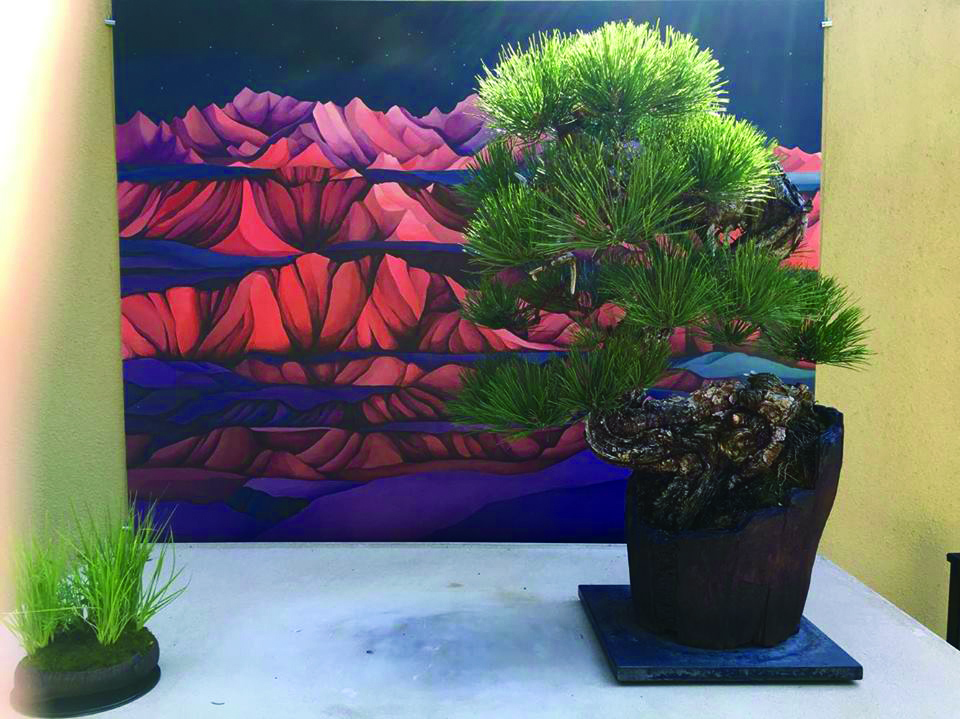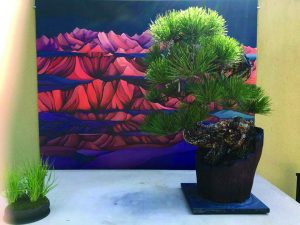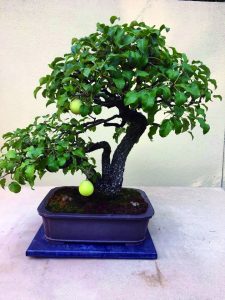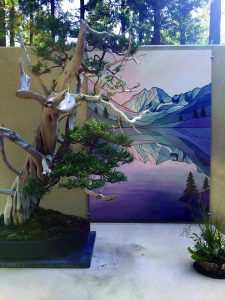
By Matthew Gulick

20 minutes north of campus, tucked in a grove of old-growth conifers just off Interstate 5, hides the Pacific Bonsai Museum. Featuring year-round collections of carefully-curated bonsai trees, the museum’s raked gravel paths wind through various kinds of trees from across the globe. With the 5’s roar muted to a far-off rumble, visitors meander from one living installation to the next while learning about the art and practice of bonsai curation.
The museum holds over 150 trees from countries such as China, Japan, Korea and Taiwan. The current exhibit, however, “Natives,” highlights trees indigenous to North America. Backdropped with paintings by contemporary Swiss artist Liuna Tinta, “Natives” displays 60 species including a Rocky Mountain Juniper, a Coast Douglas Fir and perhaps the world’s oldest Redwood bonsai. These installations include accent plantings by kusamono artist Young Choe and bonsai potter Vicki Chamberlain to recreate the feel of each tree’s native ecosystem. Even the pots the trees grow in are made of rock from their natural habitat.
“What I’m trying to do is show people how they can relate to bonsai. I’m trying to meet them where they’re at, to show you don’t have to learn Japanese philosophy and Zen Buddhism and all of these foreign concepts to appreciate bonsai,” museum curator Aarin Packard said. “The point is to have it resonate with people, for them to connect with it. For example, me being from California, I feel strongly connected to the display of Yosemite Valley that has the Sierra Juniper that I worked really hard on restyling. I had a guy from Tennessee and the Blue Ridge Mountains one was the one he liked the best.”

Packard notes that the museum seeks to introduce people to the world of bonsai, and to teach them about the nature they are observing
“One of the common misconceptions of bonsai is that it is a type of tree, like that it is a species of tree. These are all normal trees that are genetically identical to the trees in the landscape. If we were to put these trees in the ground and walk away they would grow to their full potential. They’re kept small through our cultivation techniques: pruning as well as the confined space that the roots have in a container,” he said.
Cultivators craft bonsai into specific shapes designed to catch the eye and lead it through the piece. Methods such as binding the tree in copper wire help achieve this effect. Packard likens these wires to tree braces.
“Bonsai is an art in the sense that we are styling these trees to resemble a naturally mature tree in a miniature form. It’s a rendition of a natural tree but applying artistic principles to that design,” Packard said. “If students wanted to see trees of the equivalent quality that we have they would have to go to Japan, or Korea, or China or Taiwan. We are the most geographically-diverse collection in the country; no other collection of bonsai has as many examples of bonsai that are reflective of different cultures. We also present bonsai in a way that’s extremely unique.”
“If students went to another bonsai collection, even in the United States, they wouldn’t have the opportunity to see bonsai presented with other visual artwork in the way that we’re doing it here. In addition to the actual space of the museum, the environment is the biggest asset we have. When you come here you are not only in this really beautiful space, but the layout and the design of the exhibit presents a clean slate where the artwork speaks for itself,” Packard said.

“It is a very beautiful and serene place” Rachel Bakke ’18 said. “The artwork in particular is quite extraordinary and adds a unique element to the experience I wasn’t expecting. I had a really wonderful time and would recommend the museum to anyone interested in thoughtful and creative forms of art.”
The museum remains open year-round, providing visitors the opportunity to see the trees as they change with the seasons. Traditionally bonsai shows take place in the winter when the deciduous trees lose their leaves and provide the most striking silhouette. As it is an open-air museum, visitors will likely need a raincoat during the later months of the year.
“Natives” closes Oct. 8, but Packard said the exhibit will most likely remain up for an additional week. Admission is free, though donations are accepted. Typical hours are from 10 a.m. to 4 p.m. Tuesday through Sunday. More information can be found at pacificbonsaimuseum.org.
